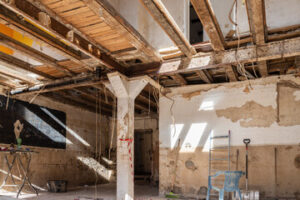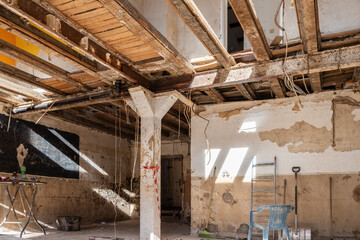Disaster restoration companies provide specialized cleaning services after natural and man-made disasters. They also help property owners in insurance claim documentation and processing.

Disaster restoration is a complex process, and it’s important to hire a company with experience in the industry. One Of A Kind Restoration helps streamline disaster restoration with low-code platform features like checklists and forms.
Disaster restoration is an essential part of recovery following natural disasters. This process restores homes, businesses, and other properties and helps people return to normal lives. However, many homeowners and property managers are not well-versed in how disaster restoration works, and as a result, they are often left scrambling to find information when disaster strikes. This can be costly, both financially and logistically.
Preparing for disaster restoration can be simple, but it must be done in advance. It is important to create a disaster restoration plan that includes the roles of each team member. It is also a good idea to conduct regular disaster preparedness training for your staff and service technicians. This can be done through regular professional seminars, in-house training sessions or even through hands-on workshops.
It is also important to understand the three phases of disaster recovery. The first is the response phase, which involves the immediate reaction to a disaster. This includes the protection of life and property, providing relief supplies, and conducting damage assessment. It is during this phase that a huge outpouring of donations from the community and voluntary agencies help to bring hope to affected individuals.
The second phase is the rebuilding phase, which usually lasts several years and involves re-establishing economic and social stability. This is when disaster survivors begin to regain their lives and re-establish their communities.
A key element of disaster restoration is restoring personal belongings. This can include furniture, cabinetry, millwork and more. This is important because it can save money on new replacements, as well as saving sentimental value for homeowners. In addition, expert restoration can often be done without destroying the items.
Another crucial component of disaster restoration is assessing and remediating mold. Mold growth can pose health risks, especially for those with allergies or asthma. Disaster restoration professionals will perform tests and conduct water damage inspections to identify any potential problems and take action accordingly. They can also provide air filtration systems and other remediation services. These steps can help to prevent mold and other environmental hazards from spreading throughout the property.
Assessment
When a disaster occurs, the first step in disaster restoration is often to assess the damage. This involves identifying what was affected, including where, when and how. It also includes determining what needs to be done to restore the property. A damage assessment may be conducted by a government agency or by private companies. It can take a long time to complete, especially after an event has occurred that disrupts communications and makes it difficult for teams to access areas where the damage is located.
Depending on the level of damage, a damaged assessment can be conducted at the individual, community or state levels. An individual damage assessment examines the physical condition of a home or personal belongings, while a community or state-wide assessment looks at the impact on infrastructure such as roads, bridges and public utilities. This information is important for determining eligibility for disaster recovery programs.
The disaster restoration process is a delicate balance between meeting client needs and minimizing liability. It is essential to establish clear company standards and best practices for conducting damage assessments. This will help you to create a consistent process and reduce the risk of miscommunication between team members. It is also crucial to use a low-code platform that can automate the process and speed up your work.
Disaster restoration requires a variety of skills and experience to ensure that buildings are structurally sound and safe for occupancy. A disaster restoration professional may also need to address issues such as water damage, smoke and fire damage, mold growth and other hazardous materials that could pose a health hazard. They will likely utilize advanced techniques to prevent further damage, restore the structure and ensure that it is a safe place for people to live.
In the days following a disaster, state, tribal and local governments will conduct an initial damage assessment (IDA) in order to determine whether they can request a federal disaster declaration. The IDA can be an Individual Assistance IDA or a Public Assistance IDA, and it must be completed within 30 days of the incident. FEMA has provided a variety of IDA survey templates that can be used to quickly collect and validate data.
Mitigation
Disasters cause widespread damage when they occur, which can result in everything from damaged homes and businesses to downed power lines. As a result, there’s a lot of debris that needs to be removed and dangerous chemicals and materials need to be properly disposed of. Restoration professionals work tirelessly to clean up after a catastrophe. However, many property managers and homeowners don’t understand how the disaster restoration process works. This is why it’s important for them to know what to look out for.
Hazard mitigation refers to the ongoing efforts at the federal, state and local level to lessen the impact of disasters. This includes preventing the loss of lives and property by keeping homes away from floodplains, engineering bridges to withstand earthquakes and creating and enforcing building codes that protect properties from hurricanes.
Stabilization is the first step in the disaster restoration process. The goal of this phase is to ensure that the affected area is safe for residents and workers. This can include removing hazardous materials, cleaning up fallen debris and securing dangerous equipment. It also involves establishing a chain of command and coordinating resources.
During this phase, a disaster restoration team will inspect the property for damage and identify priorities for recovery. They may need to remove contaminated soil from the site, perform mold testing and inspections of water damage and repair any structural damage that occurred.
In addition, the stabilization phase can also include providing temporary housing and food assistance for displaced people. This can be a huge benefit for those who have been forced to evacuate their homes during a natural disaster.
Disaster restoration can be a long and complicated process. It’s important for property owners and managers to partner with a company that has the experience, knowledge and resources to handle these types of emergencies. By doing so, they can rest assured knowing that their property is in good hands. Lastly, it’s important to keep in mind that it’s crucial to prioritize personal safety during a disaster. This includes seeking medical attention for any injuries or illnesses, if necessary.
Restoration
Disasters can be a devastating experience for homes and businesses, leaving behind severe damage that can seem overwhelming. But, the good news is that disaster restoration companies can help with the repair process and return damaged buildings to their pre-disaster condition. They are professionals in their field and can perform a wide variety of services. They can clean up sewage, restore water-damaged documents, repair electrical systems and more. Their main goal is to get you back on your feet after a disaster.
A specialized company will also know how to handle insurance claims after a disaster. They will be familiar with the documentation and reporting required for faster approvals, and they can even provide billing services to insured clients. They will also be able to assist you in developing priority lists for repairs and other tasks that need to be completed after the emergency is over.
After an initial assessment, the first step of disaster restoration is stabilizing the area. This includes securing the site, taking inventory of all damages and noting potential hazards such as fallen structures or downed power lines.
Once the site is stabilized, professionals can begin to restore the building’s interior. This includes repairing and cleaning up any water damage, conducting foundation inspections, performing mold testing and remediation as necessary, and making the building safe for occupancy.
As part of this step, it is critical to use personal protective equipment (PPE) such as protective suits, safety glasses and gloves. These products will protect the team members from harmful contaminants and debris during the restoration process. Tyvek coveralls are a good choice because they are made of low-static materials and block airborne particles, but are also breathable and comfortable to work in. Containment poles, such as Trimaco’s Heavy Duty E-Z Poles, are also a must for this step. They help create a confined and clean area for the recovery and renovation process and can be used with plastic sheeting to keep contaminants contained.
When choosing a disaster restoration service provider, look for one that communicates well with you and keeps you updated throughout the entire process. They should be available 24/7 and be able to address your concerns in a timely manner. A company that does not communicate with you or takes too long to respond can cost more money in the long run.
